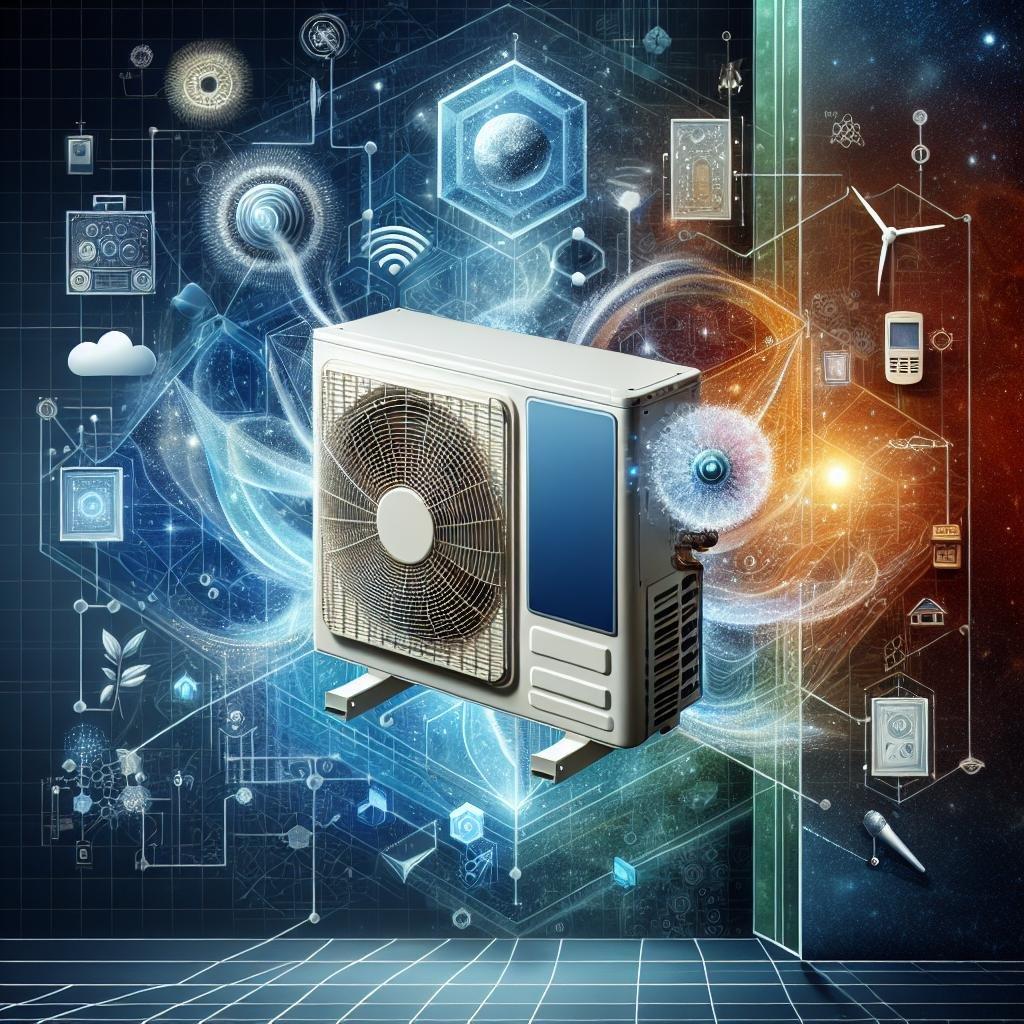In an era where technology enhances almost every aspect of our lives, the commercial building landscape is undergoing a significant transformation. Among the pivotal advancements shaping this evolution is the rise of Wi-Fi enabled mini split AC systems. Gone are the days when climate control was a matter of simple switches adn dials; today, smart heating and cooling solutions offer not only comfort but a suite of operational benefits that elevate efficiency and sustainability. In this article, we explore the myriad advantages of integrating these cutting-edge systems within smart commercial buildings. From energy savings to remote management capabilities, discover how Wi-Fi enabled mini splits are redefining the way businesses approach air conditioning, all while enhancing the overall tenant experience. Join us as we delve into the future of climate control and the pivotal role these innovative systems play in shaping modern commercial spaces.
The Integration of Wi-Fi Technology in Mini Split AC Systems
The incorporation of Wi-Fi technology in mini split AC systems marks a revolutionary step toward smarter commercial buildings. With the ability to connect to a building’s network, these systems offer unprecedented control and adaptability for users. Owners can manage their heating and cooling preferences remotely through smartphone applications, ensuring optimal comfort for occupants while minimizing energy consumption.This remote capability enables businesses to monitor their energy use in real-time,contributing to sustainability efforts and reducing operational costs.
Furthermore, the integration of Wi-Fi enhances the overall functionality of mini split systems.Users can set up automatic schedules to regulate temperature based on occupancy,optimizing energy usage during off-hours. advanced diagnostic tools provide alerts for maintenance needs, which helps in avoiding costly repairs and system downtimes. The benefits extend to:
- Energy Efficiency: Reduced energy costs due to better monitoring and control.
- Convenience: Easy adjustments and monitoring from any device.
- Integration: Compatibility with existing smart building systems.

Enhancing Energy Efficiency and Cost Savings Through Smart Cooling Solutions
In a world where environmental concerns and operational costs are increasingly at the forefront of business strategies, Wi-Fi enabled mini split AC systems offer a revolutionary approach to enhancing energy efficiency. By allowing businesses to control cooling settings remotely,these smart systems empower managers to optimize energy consumption based on real-time occupancy data and environmental conditions. This capability leads to significant energy savings and allows for more sustainable practices, as businesses can minimize waste by reducing cooling in unoccupied areas.
The benefits extend beyond energy savings, with additional cost efficiencies realized through lower maintenance and repair bills. The smart diagnostics feature of these systems can alert facility managers of potential issues before they escalate, preventing costly breakdowns and downtime.Consider the following advantages:
- Remote control: allows for adjustments from anywhere.
- Data analytics: Provides insights into usage patterns for further optimization.
- flexible installation: Ideal for varied commercial building layouts.
- Improved indoor air quality: Helps maintain a healthier work environment.
To illustrate the potential cost savings associated with smart cooling technologies, the following table provides a simple comparison of estimated energy costs over a year between customary AC units and Wi-Fi enabled mini split systems:
| AC System Type | Annual Energy Cost Estimate | Potential savings |
|---|---|---|
| Traditional AC Units | $2,500 | N/A |
| Wi-Fi Enabled Mini Split | $1,800 | $700 |
By adopting Wi-Fi enabled mini split AC systems in smart commercial buildings, businesses can reap long-term benefits both in terms of financial savings and contributing to a greener future. As the demand for energy-efficient solutions continues to grow, integrating such technologies becomes not only a competitive advantage but a critical step towards sustainability in commercial environments.

Improving Indoor Air Quality and Comfort in Commercial Spaces
In the quest for enhancing the ambiance of commercial spaces, wi-Fi enabled mini-split AC systems offer a multifaceted approach to improving indoor air quality and comfort. Equipped with advanced technology, these systems allow operators to monitor and control air quality metrics remotely, ensuring that temperature, humidity, and airflow are optimized at all times. This capability not only fosters a more pleasant environment for employees and clients but also reduces the risk of mold and bacteria growth, common challenges in poorly ventilated areas. Key features of these systems include:
- Remote Monitoring: Access to real-time data and control via mobile devices.
- Customizable Zones: Individual temperature control for different areas, enhancing comfort.
- Energy Efficiency: Eco-pleasant designs contribute to lower operational costs and carbon footprints.
Building on the advantages of smart technology, the integration of Wi-Fi enabled mini-splits in commercial settings also supports sustainability initiatives and contributes to overall well-being. With features such as programmable schedules and energy usage tracking, businesses can considerably reduce energy consumption. Understanding the impact on both health and productivity, many establishments are now reporting measured improvements in employee satisfaction and performance due to enhanced indoor conditions. Consider the following comparison of traditional systems versus Wi-Fi enabled mini-splits:
| Feature | Traditional Systems | Wi-Fi Enabled Mini-Splits |
|---|---|---|
| Control Method | Manual Thermostat | Smartphone App |
| Air Quality Monitoring | None | Real-time Data |
| Energy Usage Reporting | Annual Reports | Instant Feedback |

Streamlining Maintenance and Remote Monitoring for Operational Excellence
In today’s fast-paced commercial landscape, Wi-Fi enabled mini-split AC systems are revolutionizing how facilities are managed and maintained. these advanced systems not only offer precise temperature control but also enable real-time remote monitoring, ensuring that the air quality and comfort in your building are consistently optimized. Through user-friendly apps, maintenance teams can swiftly identify and address issues, greatly reducing downtime and improving response efficiency. This ability to monitor performance from anywhere eliminates needless disruptions, allowing businesses to focus on their core operations while enhancing the overall employee experience.
Furthermore, the integration of such innovative cooling systems leads to significant energy savings and an eco-friendly operational footprint. By enabling complex scheduling and energy usage tracking, businesses can harness deeper insights into their consumption patterns. The data can be easily viewed and analyzed, allowing for proactive adjustments that not only contribute to sustainability goals but also lower operational costs. These systems are now more than just temperature regulators; they embody a critical component of modern smart building infrastructure, providing a seamless blend of convenience, efficiency, and reliability.
Q&A
Q&A: The Benefits of Wi-Fi Enabled Mini Split AC Systems for Smart Commercial Buildings
Q1: What exactly is a Wi-Fi enabled mini split AC system?
A: A Wi-Fi enabled mini split AC system is a type of air conditioning system that consists of an outdoor unit connected to one or more indoor units, allowing for efficient temperature control in individual rooms or zones.The Wi-Fi capability allows users to control and monitor the system remotely via an app on their smartphones or other smart devices. This integration of technology provides enhanced convenience and energy management.
Q2: How do Wi-Fi enabled mini split systems improve energy efficiency in commercial buildings?
A: These systems use advanced inverter technology that adjusts cooling and heating output based on real-time conditions, optimizing energy use. With the ability to monitor and control temperatures remotely, facility managers can adjust settings to avoid unnecessary energy consumption during off-hours or when spaces are unoccupied, ultimately leading to reduced energy costs.
Q3: In what ways do Wi-Fi capabilities enhance user experience?
A: The user experience is significantly elevated through features such as remote access and real-time notifications. Users can adjust temperatures before arriving at the building, receive alerts for maintenance needs, and even set schedules for different zones. This level of control enhances comfort while empowering users to create an environment that meets their specific needs.
Q4: Can Wi-Fi enabled mini splits help in maintaining better indoor air quality?
A: Absolutely.Many Wi-Fi enabled mini split systems come equipped with advanced air filters capable of removing allergens and pollutants. Some models also include sensors that monitor air quality and send alerts if contaminants reach critical levels. When combined with remote control features, facility managers can respond quickly if air quality deteriorates, ensuring a healthier indoor environment.
Q5: how does the installation of these systems contribute to smart building design?
A: The integration of wi-Fi enabled mini split systems is a step toward achieving a truly smart building. They complement other smart technologies such as IoT devices, automated lighting, and energy management systems, creating a cohesive ecosystem. The modular nature of mini splits also allows for flexible installation, which is ideal in commercial settings where space and zoning might vary.
Q6: What are potential cost savings associated with Wi-Fi enabled mini split AC systems?
A: While the initial investment might be higher compared to conventional systems, the long-term savings can be significant. Efficient energy use translates to lower utility bills. Furthermore, easy maintenance access through alerts can prevent costly repairs and downtime. Tax incentives and rebates for energy-efficient systems may also apply, further enhancing cost savings.
Q7: Are there any challenges or considerations when implementing these systems in a commercial setting?
A: Yes, some considerations include ensuring robust Wi-Fi connectivity throughout the building for optimal performance. Additionally, staff training may be necessary to maximize the effectiveness of remote management features. It’s also essential to choose reputable brands known for reliability and customer support. Proper installation and maintenance are crucial to fully harness the benefits of these systems.
Q8: What does the future hold for wi-Fi enabled mini split systems in smart commercial buildings?
A: As technology continues to evolve,we can expect increased integration with AI and machine learning,allowing systems to optimize energy use automatically based on usage patterns. Greater emphasis on sustainability will drive innovations in these systems,making them smarter,more efficient,and more beneficial for both occupants and building owners. Wi-Fi enabled mini splits will undoubtedly play a pivotal role in shaping the future of commercial spaces.
—
This Q&A format offers insightful answers tailored to those interested in the intersection of technology and HVAC solutions in commercial environments.
To Wrap It Up
as the landscape of commercial buildings continues to evolve with the integration of smart technology,Wi-Fi enabled mini split AC systems stand out as a beacon of innovation and efficiency. these systems not only promise superior climate control but also enhance operational flexibility, cost savings, and environmental sustainability.By seamlessly connecting to management systems and allowing remote access, they empower building operators and occupants alike to create pleasant and productive environments with ease. As we look toward a future where smart buildings become the norm rather than the exception, embracing technology like Wi-Fi enabled mini splits will be crucial. investing in these advanced systems is not merely about keeping cool; it’s about cultivating smarter, more responsive spaces that adapt to the needs of the people who inhabit them. In this age of interconnectedness, let us not forget the comfort and efficiency that lie at the heart of our commercial spaces, ensuring they thrive in an ever-changing world.

